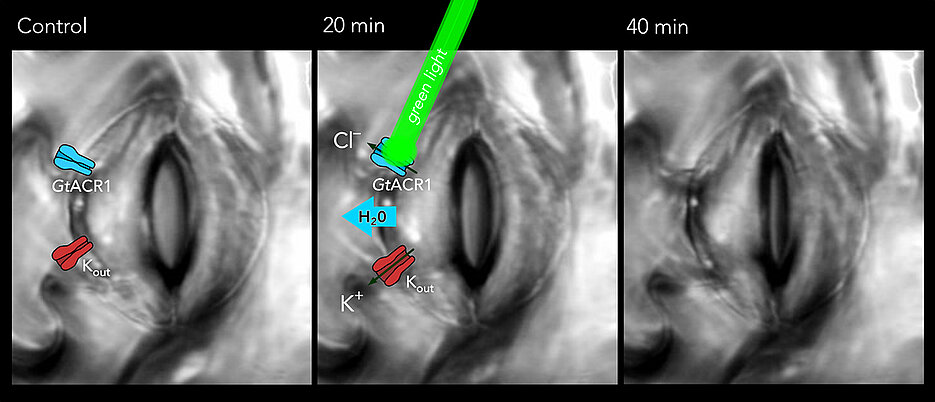Remote Control for Plants
07/09/2021Plant researchers have a potent new tool at disposal: In the journal Science Advances, a research team from Würzburg shows how to close the stomata of leaves using light pulses.

Plants have microscopically small pores on the surface of their leaves, the stomata. With their help, they regulate the influx of carbon dioxide for photosynthesis. They also use the stomata to prevent the loss of too much water and withering away during drought.
The stomatal pores are surrounded by two guard cells. If the internal pressure of these cells drops, they slacken and close the pore. If the pressure rises, the cells move apart and the pore widens.
The stomatal movements are thus regulated by the guard cells. Signalling pathways in these cells are so complex that it is difficult for humans to intervene with them directly. However, researchers of the Julius-Maximilians-Universität (JMU) Würzburg in Bavaria, Germany, nevertheless found a way to control the movements of stomata remotely – using light pulses.
Light-sensitive protein from algae used
The researchers succeeded in doing this by introducing a light-sensitive switch into the guard cells of tobacco plants. This technology was adopted from optogenetics. It has been successfully exploited in animal cells, but the application in plant cells it is still in its infancy.
The team led by JMU biophysicist and guard cell expert Professor Rainer Hedrich describes their approach in the prestigious scientific journal Science Advances. JMU researchers Shouguang Huang (first author), Kai Konrad and Rob Roelfsema were significantly involved.
The group used a light-sensitive protein from the alga Guillardia theta as a light switch, namely the anion channel ACR1 from the group of channelrhodopsins. In response to light pulses, the switch ensures that chloride flows out of the guard cells and potassium follows. The guard cells lose internal pressure, slacken and the pore closes within 15 minutes. "The light pulse is like a remote control for the movement of the stomata," says Hedrich.
Anion channel hypothesis confirmed
"By exposing ACR1 to light, we have bridged the cell's own signalling chain, thus proving the hypothesis that the opening of anion channels is essential and sufficient for stomatal closure," Hedrich summarises the results of the study. The exposure to light had almost completely prevented the transpiration of the plants.
With this knowledge, it is now possible to cultivate plants with an increased number of anion channels in the guard cells. Plants equipped in this way should close their stomata more quickly in response to approaching heat waves and thus be better able to cope with periods of drought.
"Plant anion channels are activated during stress; this process is dependent on calcium. In a follow up optogenetics project, we want to use calcium-conducting channelrhodopsins to specifically allow calcium to flow into the guard cells cell through exposure to light and to understand the mechanism of anion channel activation in detail," Hedrich outlines the upcoming goals of his research.
Basic scientific research can also benefit from the results from Würzburg: "Our new optogenetic tool has enormous potential for research," says the JMU professor. "With it, we can gain new insights into how plants regulate their water consumption and how carbon dioxide fixation and stomatal movements are coupled."
Publication
Optogenetic control of the guard cell membrane potential and stomatal movement by the light-gated anion channel GtACR1, Science Advances, 9 July 2021, DOI: 10.1126/sciadv.abg4619
Contact person
Prof. Dr. Rainer Hedrich, Chair of Botany I (Plant Physiology and Biophysics), University of Wuerzburg, T +49 931 31-86100, hedrich@botanik.uni-wuerzburg.de






